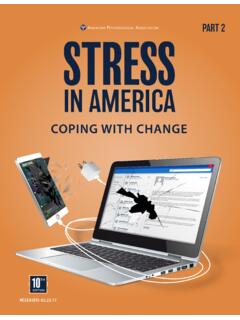Transcription of Overview of Particle Air Pollution (PM2.5 and PM10)
1 Overview of Particle Air Pollution ( and PM10). Air Quality Communication Workshop San Salvador, El Salvador April 16-17, 2012. What is Particle Air Pollution ? Particulate matter (PM), also called Particle Pollution , is a general term for extremely small particles and liquid droplets in the atmosphere (fine particles): d m PM10 (coarse particles): d 10 m Primary sources: Incomplete combustion Automobile emissions Dust Cooking Secondary sources: Chemical reactions in the atmosphere 2. Wood-Burning Stoves Forest Fires Diesel Engines Natural Sources Cars and Buses There are many sources of Particle Pollution Non-Road Vehicles Agricultural Burning Industry 3. Sizes and Composition of Particulate Matter Fine Coarse Anthropogenic: Natural: Ultra-Fine Sulfates Soil Abundance Nitrates Dust Ammonia Seasalt Carbon Bioaerosols Lead Organics m 1 m m 10 m Aerosol Aerodynamic Diameter (1 m = 1 x 10-6 m) 4. Why Is it Important to Communicate Information about Particle Pollution to the Public?
2 Exposure to Particle Pollution is a public health hazard When inhaled, Particle Pollution can travel deep into the lungs and cause or aggravate heart and lung diseases Exposure to Particle Pollution causes increases in: Doctor and emergency room visits Hospital admissions Use of prescription medication Absences from work and school 5. Particle Pollution Affects the Lungs People are exposed to Particle Pollution when they breathe Effects of short-term (acute) exposure: Coughing Shortness of breath Tightness of the chest Irritation of the eyes Effects of long-term (chronic) exposure: Reduced lung function Development of respiratory diseases in children Aggravation of existing lung diseases Premature death of people with lung disease 6. Particle Pollution Affects the Heart Inhaled particles can pass from the lungs into the bloodstream and affect the cardiovascular system Effects of short-term (acute) exposure: Irregular heart beat Nonfatal heart attacks Effects of long-term (chronic) exposure: Aggravation of existing heart diseases Premature death of people with heart disease 7.
3 Certain Groups Are Most at Risk from Exposure to Particle Pollution Children Lungs are still developing Spend more time at high activity levels Senior citizens May have undiagnosed heart or lung diseases People with existing heart or lung diseases Particle Pollution aggravates these diseases People who exercise or work outdoors Breathe faster and deeper than sedentary adults 8. Famous Particle Air Pollution Episodes Denora, Pennsylvania, USA London, England October 26-31, 1948 December 4-9, 1952. air Pollution kills 20 people air Pollution kills 4000 people London at 10:30 AM. Donora at noon 9. Pyramid of Health Effects from Air Pollution Adversity of Effects Death Visits to emergency room, hospitalization Visits to doctors, absences from school and work Use of medication, asthma attacks Lung inflammation, coughing, increased susceptibility to infection, cardiac effects Proportion of Population Affected 10. Communicating Health Effects Morbidity Increased frequency of chronic bronchitis, respiratory hospital admissions, restricted activity days, etc.
4 Disability-Adjusted Life Year (DALY). Indicates how a disease can alter the ability of people to live a normal life compared to those with no disease Expresses years of lost life Mortality (number of deaths). 11. Examples of Health Effects for Europe Air Pollution causes of deaths of European children age 0-4 years Air Pollution causes 100,000 deaths and 725,000. years of lost life (DALY) in European cities Pollution caused 350,000 premature deaths in 2000. European citizens have a decrease in average life expectancy of 9 months due to air Pollution 12. Annual Impacts of Air Pollution in the Human exposure to outdoor air Pollution costs between $40 to $50 billion 50,000 to 120,000 premature deaths are associated with exposure to air Pollution People with asthma experience more than 100 million days of restricted activity Costs associated with treating asthma exceed $4 billion About 4,000 people die of asthma 13. Summary Particulate matter (PM) is a general term for very small solid and liquid particles in the atmosphere There are many different sources of PM, including natural and anthropogenic (man-made) sources PM is hazardous to human health it causes acute and chronic effects to the respiratory and cardiovascular systems PM causes a variety of human health and economic impacts each year ( , mortality, morbidity, DALYs, lost income from work absences, costs of health care).
5 14.










